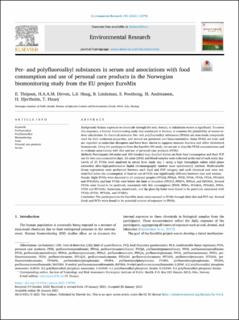| dc.description.abstract | Background: Human exposure to chemicals through the oral, dermal, or inhalation routes is significant. To assess this exposure, a human biomonitoring study was conducted in Norway to examine the plausibility of source-to- dose calculations for chemical mixtures. Per- and polyfluoroalkyl substances (PFASs) are man-made compounds used for their surfactant properties, and several are persistent and bioaccumulative. Some PFASs are toxic and are regarded as endocrine disruptors and have been shown to suppress immune function and affect cholesterol homeostasis. Using the participants from the EuroMix BM study, we set out to describe PFAS concentrations and to evaluate associations with diet and use of personal care products (PCPs). Methods: Participants (44 males and 100 females) kept detailed diaries on their food consumption and their PCP use for two non-consecutive days. All urine (24 h) and blood samples were collected at the end of each study day. Levels of 25 PFASs were analysed in serum from study day 1 using a high throughput online solid phase extraction ultra-high-performance liquid chromatography tandem mass spectrometry method. Multivariable linear regressions were performed between each food and PCP category and each chemical and were sex- stratified when the consumption of food or use of PCPs was significantly different between men and women. Results: Eight PFASs were detected in all analysed samples (PFHxS, PFHpS, PFOS, PFOA, PFNA, PFDA, PFUnDA and PFDoDA), and four PFASs were below the limit of detection (PFOPA, PFDPA, PFHxA, and EtFOSA). Several PFASs were found to be positively associated with fish consumption (PFOS, PFNA, PFUnDA, PFDoDA, PFDA, PFDS and PFTrDA). Sunscreen, mouthwash, and lip gloss/lip balm were found to be positively associated with PFASs (PFOA, PFTrDA, and PFOSA). Conclusion: The participants in the EuroMix study were exposed to PFASs through their diet and PCP use. Several foods and PCPs were found to be potential sources of exposure to PFASs. | |
